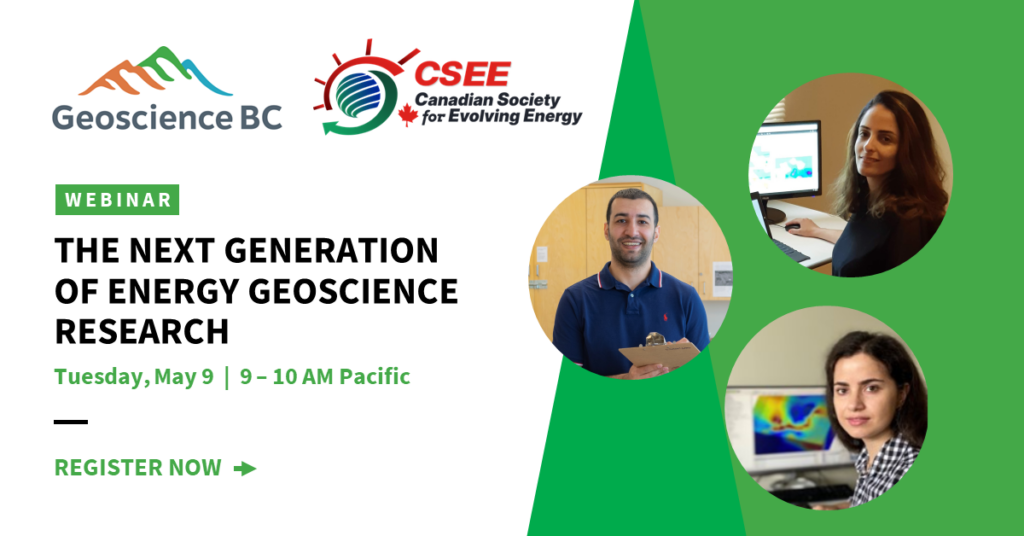The Next Generation of Energy Geoscience Research
Vancouver, BC – May 2, 2023 – Geoscience BC 2022 Scholarship Program recipients will be presenting their research projects at a special webinar co-hosted with Canadian Society for Evolving Energy (CSEE) on Tuesday, May 9, 2023 from 10:00 am to 11:00 am MST (9:00 am to 10:00 am PST). Students will present their geothermal, carbon capture and storage and seismicity research, followed by a live panel discussion.
**PRE-REGISTRATION IS MANDATORY**
Limited availability. Registration will close on May 8, 2023 at 3:00 pm MST
Presentation 1: Influence of Fracture and Fault Systems on Fluid Flow in the Garibaldi Volcanic Belt, BC
Presented by: Fateme Hormozzade, Ph.D., Student Carleton University
Fateme's Ph.D. thesis focuses on the use of audio-magnetotelluric (AMT) data to explore for shallow geothermal resources in the Garibaldi Volcanic Belt in BC's Southwest Region. This research project aims to identify the influence of fault and fracture networks on permeability and shallow fluid circulation at the Mount Meager Volcanic Complex (MMVC). Combining new AMT data with legacy magnetotelluric (MT) and 3-D inversion techniques, this project will generate a new electrical resistivity model which provides information about the hydrothermal system and fluid flow in the subsurface of MMVC. Fateme will incorporate well logs and petrophysical and fluid properties into the model to examine the influence of fracture and fault networks on rock physical properties. Subsequently, reservoir characteristics and petrophysical trends will be estimated and optimized for the survey area, using machine learning algorithms. Furthermore, this project will contribute to the development of conceptual models of the hydrothermal system flow regime, which could be used to reduce the risk of future development of geothermal resources.
Presentation 2: 3D Reconstruction of the Georgia Basin and Potential for Carbon Capture Sequestration in the Lower Mainland, BC
Presented by: Maziyar Nazemi, Ph.D., Student Simon Fraser University
The region of BC known as the Lower Mainland (LMBC) hosts approximately 60% of BC's population and industrial activities and as such is a major source of greenhouse gas emissions in the province. Little is known about the reservoir potential of the sedimentary strata underlying LMBC, and therefore, the potential for carbon storage is uncertain. The goal of this research program is to build an integrated 3D geological model for the Georgia Basin strata that underlie the LMBC. This will be used to simulate CO2-water flow in the subsurface and hence assess the technical aspects of implementing carbon capture, utilization and storage (CCUS). The model will be built by re-evaluating existing datasets and incorporating new ones. These data will be used to evaluate reservoir potential characterization, and construct a 3D static model of sedimentary strata and the static geological model in the LMBC. Through this work, he will develop and assess the feasibility of underground CO2 storage and its integration with enhanced geothermal energy recovery. Alternatively, the project will implement machine learning to apply algorithms to interpolate sand distribution between subsurface wells. From these data, Maziyar will identify the most prospective horizons and locations of CO2 storage in the LMBC.
Presentation 3 : Investigating Fault Sealing Effects on Induced Seismicity and Pore Pressure Distribution and Fracture Propagation in Northeast BC
Presented by: Zahra Esmaeilzadeh, Ph.D., Student, University of Calgary
On November 30, 2018, an earthquake sequence was initiated during hydraulic fracturing operations in the Septimus region of the Montney Formation in British Columbia's Northeast Region. When this sequence was initiated, zipper-fracking was being carried out in two lower-middle Montney wells. It has been proposed that variations in pore pressure within the Montney unconventional play reflect fault-bounded pressure compartments. A measured static pressure difference of 10 MPa between the two wells indicates that they may be separated by an impermeable fault. In this project, we review available data from Northeast British Columbia, with the objective of reappraising pressure terrane boundaries, and evaluating the relationship between fault structures, pressure terranes and induced seismicity. We also characterize the influence of a lateral pore-pressure gradient on completion effectiveness and fault activation
The Geoscience BC Scholarship Program 2023 is open, and available for sponsorship! It awards up to ten scholarships to students who have registered and started in a MSc or PhD program in earth science, geoscience or applied geoscience. Registration will close on May 8, 2023 at 4:00 pm Pacific.
GEOSCIENCE BC SCHOLARSHIP PROGRAM
About Geoscience BC
Geoscience BC generates independent, public geoscience research and data about British Columbia’s minerals, energy and water resources. This advances knowledge, informs responsible development, encourages investment and stimulates innovation.
Our collaboration with the resource sectors, academia, communities, Indigenous groups and government develops and shares unbiased and credible earth science research and data.
Geoscience BC is a not-for-profit society incorporated under the BC Societies Act.
Visit geosciencebc.com or follow us @GeoscienceBC to find out more.
For more information, please contact
Richard Truman
Geoscience BC
604-662-4147 / 778-929-1662
